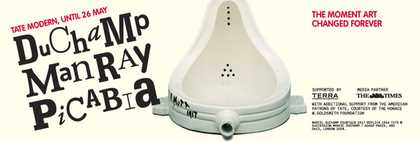The work of Emila Medková represents one of the most sustained and critically engaged examples of surrealist documentary photography, although it has been seen only rarely outside of the Czech Republic in either exhibition or reproduction, and her name is likely to be entirely unfamiliar to English-language readers. Born in 1928 and active from the late 1940s until a few years before her death in 1985, this invisibility echoes the phantom existence of the post-war Czech surrealist group of which she was a central member, a fascinating and dynamic intellectual circle which over the period in question enjoyed no more than a few years of public existence, the remaining three decades being spent underground.
Medková’s important place in the history of post-war Czech surrealism is also mirrored by her position within what can justifiably be termed a tradition of Czech surrealist photography spanning no fewer than seventy years (to the present day, with the still-active Czech and Slovak Surrealist group), many of whose attitudes and themes she exemplifies. Although material in the field has become more readily available since the Velvet Revolution of 1989, this intriguing history remains almost entirely unknown to audiences outside central Europe, and closer inspection reveals rich contrasts to the Northern European (by which is usually meant Paris-based) surrealist photography with which viewers and readers have become familiar. One can comfortably count over a dozen Czech surrealist photographers (considerably more if one includes those using the medium more occasionally), all of them with direct links to surrealist groups and many of them – in contrast to the ‘stars’ of French surrealist photography like Brassaï or Boiffard – keenly committed to surrealist positions. Whereas in France, for example, the importance of photography for the group seems, if anything, to have diminished after the war, in Czechoslovakia surrealist photography developed hand-in-hand with the movement’s critical debates; and all the while a remarkable sense of continuity and commonality emerges from a great proportion of its images, fostered in part by the very specific cultural and political geography upon which its lenses were trained.1
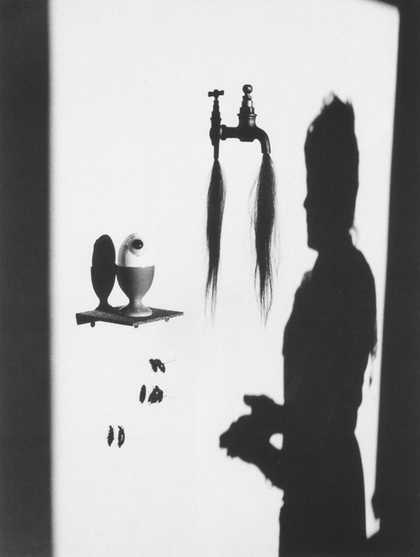
Fig.1
Emila Medková
Cascade of Hair 1949
Black and white photograph
Artist’s estate © Eva Kosáková
Medková’s earliest photographs such as Cascade of Hair 1949 (fig.1), perhaps unsurprisingly, seem something of a resumé of pre-war surrealism’s use of constructed photography and the surrealist object typified by the work of Man Ray. Trained from an early age under Josef Ehm in the photography department of the School of Graphic Arts, Prague, she would have encountered other leading figures from photography’s avant-garde such as Jaromír Funke and Eugen Wiškowský, and it was more than likely that a lively and informed awareness of both Czech and international surrealist visual practice was current along its corridors.2 Formed in Prague in 1934 as in many ways a logical development from the previous decade of the Czech avant-garde, the Czech surrealist group had enjoyed a high public profile before the war forced its temporary eclipse, establishing international links and an intellectual credibility that was both in dialogue with, yet already easily distinguished, from its Parisian counterpart. Over this period, though Medková would probably have been too young to witness them herself, venues such as the Mánes Gallery had hosted major exhibitions featuring both international surrealism and wider avant-garde photography from Germany and France, and images were also readily available in print; in a sense, despite the events of the war, surrealism was still very much ‘in the air’ in 1940s Prague, and there was more than one group of younger artists, writers and photographers formed around this time that declared itself in sympathy with the surrealist cause.
Cascade of Hair, like many of Medková’s Shadowplay cycle of photographs from the late 1940s, rehearses uncomfortable apparitions, the migration of meanings between objects (egg/eye, water/hair), and the rudderless drift between the natural and human worlds familiar from much surrealist painting of the 1930s. Sharp contrast gives the shadows an oblique dense quality with as much truth as the ‘real’ objects that cast them – as if already to suggest the surrealist photographic image’s status as one that, however skewed it may appear, nonetheless insists on equal status with the world projecting it; a hazier female shadow – one guesses of the photographer herself, the one ‘absent’ object – confronts the scene with a tentative gesture, her presence as a mere person less certain than the uncanny juxtapositions stuck to a wall as luminous and as insubstantial as a mirror. The photograph’s most direct external reference, in fact, is the painting The Myth of Light, painted by the Czech surrealist painter Toyen (a major figure from the pre-war group) in 1946, the year before her definitive departure for Paris: in it, a shadow of a male figure cast onto a door appears to hold an actual plant whose bunches of thin roots fall like tresses, met by gloved female hands mimicking a shadow guard dog. Already, verifying photographic answers to the enigmas posed by painting had become a theme for Medková, and the work of Toyen in particular (another major Czech surrealist whose status in the official guidebooks needs serious revision) would remain an important point of reference for her, albeit with quite different results.
Slightly forced in their self-conscious dramatisations as they are, the staged photographs of this period have something of an atmosphere of febrile, cooped-up past-times, as though staged while waiting for something else. Many of them were made in partnership with the man Medková had first met at the School of Graphic Arts in 1942, the painter Mikuláš Medek. Together and from the late 1940s until the latter’s death in 1974, the Medeks formed a couple whose partnership seems to have been a fertile source of creative and intellectual exchange working in a complex interplay that was clearly productive for both bodies of work (though Medek’s disfavour with the Czech authorities during the 1950s also impacted significantly on the way in which Medková could pursue her own career, obliging her to earn a living as a technical photographer while her husband remained at home to take care of their daughter). The year the Medeks married, 1951, was also the year the couple joined the rekindled activities of the Czech surrealist group formed around the writer, artist and designer Karel Teige. Teige, already a major figure of the Czech avant-garde in the early 1930s, had been the chief theorist of pre-war Czech surrealism, but the defections, deaths and emigrations that had compounded the group’s demise under occupation left him as its sole survivor; it was only very gradually that a younger generation of writers and artists gathered around him again at the turn of the decade.
For the reformed group this period, however, was characterised by a climate once again as unfavourable as it had been a decade before. After a brief hiatus immediately after the cessation of hostilities, the establishment between 1946 and 1948 of a Stalinist state aligned with the Soviet Union heralded the beginning of an extended period of cultural repression that was to last for the next four decades (punctuated only by a gradual relaxation in the mid-Sixties that was to be sharply revoked in its turn after the events of the ‘Prague Spring’ of 1968). Surrealism and its outcomes were strongly censured by the state media, and Teige in particular – whose pre-war position had been characterised by a determination to reconcile surrealist ideals with party political revolutionary demands – was hounded by the authorities to the point that his untimely death only months later was widely interpreted as a direct result of state and police pressure. Under these conditions, any organised surrealist activity in Czechoslovakia could only be on condition of covert activity, and for the majority of the period in question the group had no public outlets at its disposal. Driven underground, the group pursued a collective intellectual existence that consisted of meeting at each other’s homes and studios to share work and debate, focusing activities in the initial period on a series of collective enquiries beginning with two Enquiries on Surrealism 1951 and 1953 and then on two cycles of collective anthologies, internal group journals ‘published’ in a single copy: the Signs of the Zodiac (1951, 10 issues) and Object (1953–62, 5 issues) (with Medková a major contributor to both series, notably the covers for several issues of Object).3

Fig.2
Emila Medková
Restaurant 1956
Black and white photograph
Artist’s estate © Eva Kosáková
Significantly, it was at precisely this time that an important shift took place in Medková’s work, away from the staged photographs so reminiscent of French surrealism’s pre-war heyday and towards an altogether tougher, more critical documentary mode. Although images of this kind had already been present in Medková’s portfolio from the 1940s, from this point on she entirely abandoned portraits, interiors-based and constructed elements, and her work was to consist solely of images found from the outside world of street, suburb and waste ground; in turn, the playful processes of the earlier works were abandoned in favour of deceptively straight, direct image making. Restaurant 1956 (fig.2) (from the Records cycle) is typical of the urban context, the frontality, medium or close detail, and apparent austerity of many of these photographs. Imposingly formal, a plaster-faced building dominates a corner of a crossroads, and pronounces its invitation in assured capitals: Restaurace. But as the hungry traveller lowers his gaze, all he meets is the ghostly negation of a front door: but for the lintel, the intermittent intervals in the stucco, and the new plaster’s telltale pallor on the lower part of the wall, the entrance has been completely, obsessively effaced, like a retouched photograph erasing a disgraced party official. A smudged out smaller notice, ‘billiards’, and shreds of a poster likewise show evidence of a determined effort to deny what the sign – and the photograph’s stubborn title – so blithely announce. Tiny traces of simple chalk graffiti, at child height, are all that can pass uncensored.
Given the social and cultural conditions of post-war Czechoslovakia, it would be very hard not to read this image as a critical, politicised statement. The themes of blockage and of cancelled or deflected communication found here are in fact characteristic of a great many of Medková’s photographs of the 1950s and early 1960s (and indeed of several other contemporary Czech surrealist photographers). Two of her major cycles grouping together images with a common theme were entitled Closed and Signs. This tendency to conceive of her practice in terms of cycles rather than isolated photographs is typical of Czech surrealist photography, and adds to the sense in which images should be read as part of an ongoing debate – as evidence of a constant vigilance over the everyday world – rather than as discrete attempts to grasp moments or find definitive forms. While the borders between cycles often seem to have been flexible in Medková’s case, and each open-ended cycle might signal a category of concern lasting many years, they also had the effect of giving the photographer’s overall practice a dynamism and mobility to counter the apparently static rigour of many specific works so that, as Petr Král suggests, ‘different photographs tend to disappear in favour of a trajectory’.4 It is in this sense that, taken as strings of linked statements, Medková’s work might be considered as an attempt to generate a new but coherent language, articulating the perversity and decay of meaning and ideas under state control in a way that might elude the bind that all language was now almost universally considered bankrupt. A major theme of the Czech surrealist group’s internal debates through the 1950 and 1960s, articulated most clearly in the joint statement by Czech and French surrealists of 1968, the Platform of Prague, was the critique of language as being manipulated and reduced under repressive systems, paralysing both structures of signification and of thought.5 Medková’s repeated focus on signs and symbols – and on their covert counterpart, graffiti – frequently tended to lay bare the means by which the physical blockage of politicised space in post-war central Europe was also accompanied by new mental impasses, the diversion or curtailment of channels of communication.
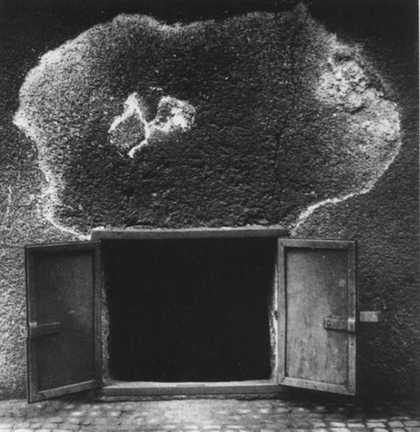
Fig.3
Emila Medková
Explosion 1959
Black and white photograph
Artist’s estate © Eva Kosáková
Images such as Explosion (fig.3), on the other hand, suggested that the very fabric of the urban environment was beginning to mutate in sympathy with the shifting mental morphology around it. Far from the ‘magic Prague’ of today’s honeyed tourist trap, in 1959 a house could become a dungeon, a door a maw, the monochrome catching the cancer-eating surfaces and exposing fissures.6 For many of the surrealists facing the climate of 1950s Czechoslovakia, where ordinary life could be ruled by absurd reversals of value and meaning, the real world of physical objects and spaces, not the world of the imagination or the unconscious, was the only valid and relevant theatre of action. The Medeks gave a joint answer to the Second Enquiry on Surrealism making this position clear. Where some of the terminology might have echoed French surrealist texts of the 1930s, it was an argument cut to a very different context:
We think that concrete irrationality and the irrational concrete are the prerequisites for modern authentic poetry and a modern feeling about life. … This reality [of 1953] is a space within which the whole of the world’s systematised chaos is reflected; it is not possible to bargain with that reality.
Any poetry that bargains and haggles with that reality, be it in the name of humanity or beauty, is not poetry in its full authenticity.7
The habitats Medková’s work documented, and the social reality it confronted, was this real here-and-now of the everyday environment around her. From the early 1950s she had begun to haunt specific districts of Prague such as Libeň and Karlín, focusing for instance on streets like Kotce with their cheap shops, and though through the 1960s the precise subject matter of the resulting photographs often grew harder to read, they would remain insistent in their facticity, always showing actual, concrete (and usually static) things.8
Photographs such as Explosion insinuate a dry, bitter humour typical of the poems and paintings of post-war Czech surrealism, but it is not one that squares easily with André Breton’s ‘black humour’ characteristic of French surrealism during and after the 1930s. Indeed, as the Czechs already recognised, the conditions for their laughter were now radically different. Vratislav Effenberger, who had taken over effective leadership of the group after Teige’s death, was to note their shift, and how their pervasive and concrete nature made photography their appropriate witness:
I wasn’t willing to swear on the dogma of ‘liberty-love-poetry’. This utopian maxim could only have muted everything that still blazed within surrealism. … The streets in which surrealists were looking for the marvellous had changed between the wars. And from the 1940s; it was a different irrationality that I had encountered there. This irrationality, produced by a decadent rationality, burst with a humour so objective that all you had to do was place it in front of a camera or on a stage for its rationalist shell to crack open and a purifying sarcasm to leap out.9
Debates within the group from 1951 onwards highlighted not only their insistence on a concrete, critical attitude foursquare against their new material conditions, but also demanded the necessity to rethink and critique surrealism’s own tenets and mythology. Evidence from the internal enquiries, in a number of which Medková participated, demonstrated a frank readiness to challenge and revise both French and Czech surrealism of the pre-war years – a self-critical and reformist attitude which seems to have been far more timid in the reformed group around Breton in Paris after the war.10 Emerging from the Devětsil movement of the 1920s that had often professed a sunny optimism about the modern world and its promise for the new Czech society, 1930s Czech surrealism also contained elements that now looked unashamedly positive. If its chief poet Vítěslav Nezval could have written:
I love the magic of despair
Shyer than the soft piste bird
I shall never sign up for it but all the same
Good-bye or farewell little nothing11
it seemed in retrospect to express a playful disquiet quite different in colour from the negation and pessimism called for now. Indeed, Effenberger initially even had serious doubts about the continued relevance of the term ‘surrealism’ at all, preferring the term ‘objective poetry’ to underscore the collective determination to abandon the utopian, imaginative thrust of 1930s surrealism which in the harsh light of 1950s Prague was now looking not only out of kilter with the times but also suspiciously idealist.12
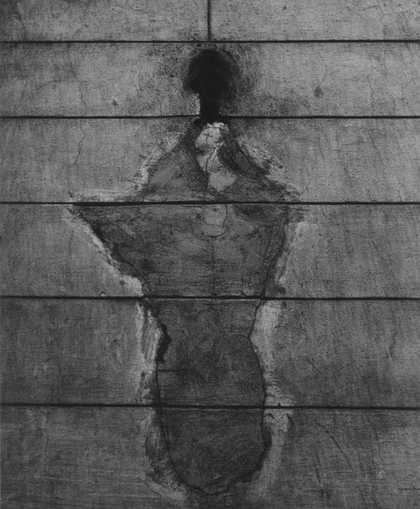
Fig.4
Emila Medková
Torso 1965
Black and white photograph
Artist’s estate © Eva Kosáková
Medková’s records of urban ghosts like Torso 1965 (fig.4), thus seem to hover between reflecting and rethinking the possibilities of surrealist image-making. Often spare, the result of a fixed stare rather than a lucky glance, they seem sometimes to have much more in common with later, more conceptual currents of European documentary photography than with the uncanny games of typical surrealist art and photography. Nevertheless, these images are frequently also highly reminiscent of currents of the Czech surrealist painting with which Medková would have been very familiar: the gaunt ochre torsos found in works by Medek from the early 1950s, or similar forms in the work of Josef Istler, and, in particular, the haunting, ambiguous series of Spectres by Toyen from around 1934, characterised by texture and colouring that already implies a plaster surface and that strongly suggests Medková’s motivation is in part a desire to track down and fix the physical evidence that might ‘prove’ surrealist painting. At another level, the situation of Medková’s operations within the search for an urban marvellous – albeit now a grim poetry of the new republic rather than the romantic efflorescence found by her predecessors – both placed her work squarely in an established surrealist tradition, and made her (like so many other Czech surrealist photographers) the inheritor of a line established by Jindřich Štyrský in his short-lived but influential urban photography of 1934–5.13 Like Štyrský, Medková’s subject matter tended towards objects and spaces rather than people. Quite lacking in the deliberate shock tactics or libidinous insinuation of ‘classic’ surrealist art, denying any utopian dreams of an embodied desire, bodies and identities are nevertheless everywhere in Medková’s photographs, discovered and often recognised (since they sometimes have names). As Alena Nádvorníková points out, anthropomorphism was to become Medková’s major interpretative tool, one that was all the more effective for avoiding veristic representation, often with the photograph’s matter-of-fact title assisting its function as a fraction of a shiver between subjective and objective states.14 Torso is unsentimental in its record of a stucco angel whose head has left a hole in the wall as though, with it wrenched out of the building’s fabric, only a nuclear flash imprint of a half-dancing form remains, plain as day but missing at the same time. Once again, like rings on a tree, walls tell tales of the lives witnessed around them, even if their pleasures and desires must now remain petrified.
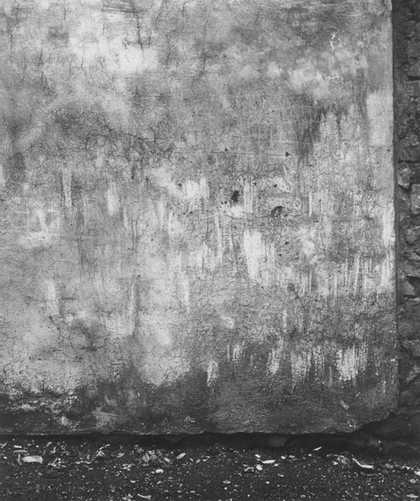
Fig.5
Emila Medková
Wall 1951
Black & white photograph
Artist’s estate © Eva Kosáková
In fact, from an early stage Medková’s range of work contained images that were even more pared-down in their reluctance to romanticise form and their obsessive fascination with detail. Wall 1951 (fig.5), presents nothing but a sheer flat surface occupying all but the lowest portion of the frame and a strip to one side. At first sight a representation of practically nothing, as with Leonardo’s apocryphal wall so often cited as an ancestor of surrealist automatic techniques, the detail gradually comes out to meet the viewer, who is drawn in and eventually overwhelmed by the wealth of incident: every hairline crack, every cracked pebble begins to look fascinating and deliberate, evoking maps or skin. Striations and faint grids marking the plaster surface hover uncertainly between accident and design, and the apparent suspension of the plane of plaster over the top of the wall’s stone surface, seeming to float just above the ground, makes the wall a gift of a canvas for spider or outsider artist alike. Medková’s focus on the everyday – on the marvellous that is forced out of the drabest prospect rather than discovered lurking there15 – is underlined in images like these that focus in on the apparently most banal and neglected sites, bereft of events. Reconstructed as a whole, these cycles of work might be seen to constitute a meticulous documentation or the world reminiscent of Eugene Atget’s painstaking photographic preservation of vanishing Paris half a century before.16 In a sense, in these images Medková presents herself as a kind of Atget of everyday detail, dispassionately recording and registering the life of each surface. Around her, however, photographs evoking the ‘poetry of the ordinary day’ were to become a bland commonplace in Czech magazines and exhibitions of the 1960s, many of them suggesting a surrealism watered-down to the level of mild surprise and sentimentality.17 Medková, in contrast, by retaining her sense of pessimism and critical context, shared with the surrealist group of the period, nevertheless acted effectively to prevent her photographs from becoming too precious or in thrall to the image.
Here more than ever, Medková’s trademark frontality is emphasised. Her use of 6x6 format cameras, as well as affording greatly heightened detail and resulting in prints that before cropping are square rather than rectangular, must also have designated a specific attitude before each subject: presenting oneself to the object with the camera not at the eye but below the chest (an extension of the body not the head), one looks down into the viewfinder: a triangulated play of vision between eye, lens and object that has the effect of distancing and formalising the relationship between photographer and the world. The result here is images that appear both to maintain a formal (and by implication moral) rigour, and in which the photographer’s gaze, and her subjectivity, seem at a considerable remove, a suggestion emphasised by Medková’s apparent disinterest in technique and reluctance to indulge in any manipulation in the processing of prints beyond cropping and occasionally inverting them by 90 or 180 degrees. Nevertheless, the issue of the author’s presence here is not one of simple effacement. ‘I photograph to document objective and subjective situations that I consider to be significant’, she had written in response to an enquiry on the reasons for creation the year Wall was taken. Commenting on an interview conducted with her in 1976, Aleš Kuneš suggests that her work represented ‘an attempt to survey her own identity in the world’.18 In a sense, if the subject behind the camera is being withdrawn, it is so that another subjectivity might be found in the most concrete of objects in front of it.19
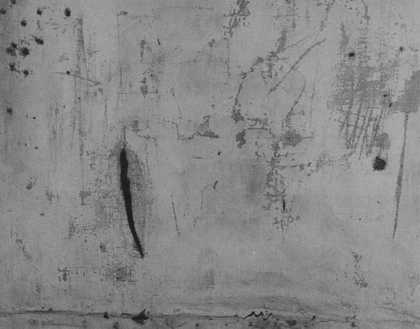
Fig.6
Emila Medková
Crevice 1961
Black and white photograph
Artist’s estate © Eva Kosáková
Medková continued to pursue images based on walls (that were thus literally confrontations with physical obstacles that could well be read as cyphers for hostile containment and political dead-ends) throughout her career. By the 1960s in particular, photographs such as Crevice 1961 (fig.6) (from a whole cycle of Crevices), homed in on details of surfaces that were part mark-making, part decay that offered a striking parallel with the developments of Czech abstraction in painting. As in the West, this Informel tendency had significant roots in surrealist art, and Mikuláš Medek was one of the leading participants in its development. While a number of his canvases indeed look like luminous, brightly-coloured equivalents for Medková’s wall photography, it would appear that she must have provided him with a key source of inspiration for this development in his work, which moved unambiguously away from figuration only in the late fifties.20 As with non-figurative painting, as several commentators have pointed out, the viewer of Medková’s more abstract images, and the cycles they constitute, is obliged to construct meaning for him or herself, in order to make sense of and reconfigure the physical realm once again in the mind. While photography’s apparent primary function – to offer recognisable likenesses that claim to reproduce rather than only imagine the world – seems here in suspension, the spectator in fact gains control, Effenberger suggests, as the photographer relaxes power.21 The critical function of these works thus remains the imaginative deconstruction and reassembly of structures of authority and meaning.
The cracks and pocks of Crevice hinted at a violence and eroticism that is almost always hidden well below the surface of Medková’s photography, but its patinated beauty as a kind of tactile drawing was tempered with a sense that the closer one looked at the concrete world, the more the viewer would find to dishearten and frustrate. Nevertheless it was true that the decade to come would see some cause for hope among radical artists and writers, and in particular the surrealist group could at last begin to countenance exhibiting and publishing their work (albeit initially under the deliberately baffling name UDS). In fact, the second half of the Sixties was precisely the period during which the Medeks took their distance from the group around Effenberger (though in her case this was not signalled by any significant shift in her practice or concerns), with Medková rejoining it in 1975 after her husband’s death the year before. Although she later professed disinterest in exhibiting her work – and satisfaction that her lack of success in any commercial sense had kept her free to pursue her work without interference – this decade was also a period in which she finally began to exhibit her work at home and abroad (notably in Warsaw 1962 and Miami 1963), saw commentaries and images available in print, and found opportunities for foreign travel.22 But these heightened expectations proved short lived; by the end of the sixties state control was reinstated once again, this time lasting another twenty years. Medková’s final cycle of photographs was entitled The End of Illusions, and though it contained themes and locations familiar from earlier work it also derived a particularly sour pleasure from finally training the lens away from the city and onto waste ground or abandoned sites, looking downwards this time onto detritus and abandoned objects.

Fig.7
Emila Medková
Arcimboldo I 1978
Black and white photograph
Artist’s Estate © Eva Kosáková
Arcimboldo I 1978 (fig.7), finds the mannerist painter’s witty object portraits on a rubbish tip, as though even emperor Rudolf II today might be no more than the sum of wasted consumer goods slung onto the dump or just another celebrity car-crash.23 Witty and disheartening at the same time, the photograph also speaks of the slow agony of the modern object, its promise of a rationalised future consigned to the rubbish heap in the terminal farce of utilitarian values. Rust, pollution and collapse seem prefigured everywhere in this cycle. Effenberger wrote in 1974:
Contemporary life represents the end of a civilisation; an ending that cannot hold back on its stock of the tragicomic churning deep down inside itself.
As the experience of history tells us, civilisations die not as a result of their economic collapse but because the functional and use values of these systems wither away as they evolve until they lose all real content.24
One would give a lot to know how Medková would have documented the seismic shifts under the new Czech Republic, where there seems nevertheless no sign of abatement in the desperate promise of the object, the noisy annexation of language, and the building of new concrete and glass horizons on every other corner. But we can make some educated guesses, for Medková’s influence, and the tradition she exemplifies, is still more than visible in the work of a number of young photographers in the Czech and Slovak surrealist group that continues to this day, maintaining its critical stance and its focus on the everyday concrete irrational, documenting the magic and despair of a new millennium.25

